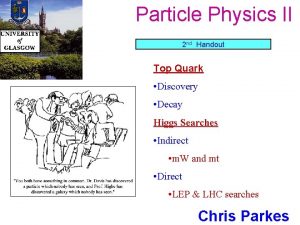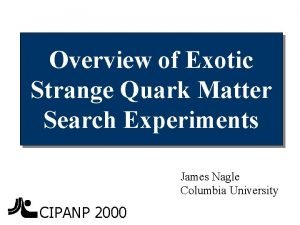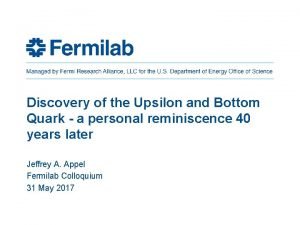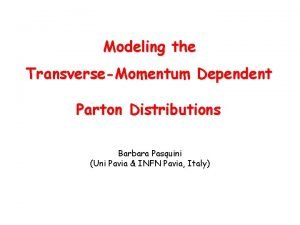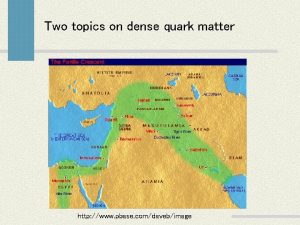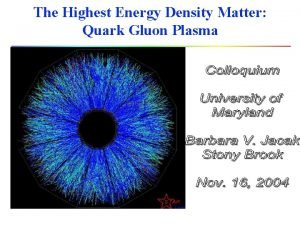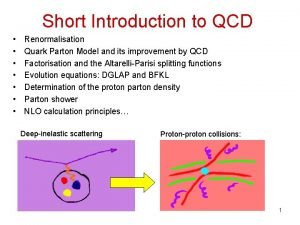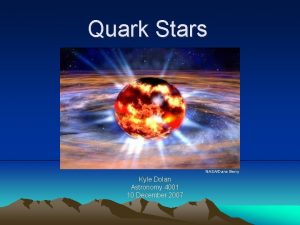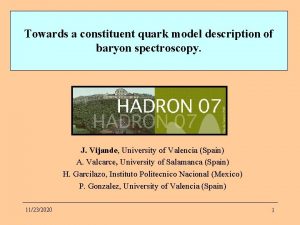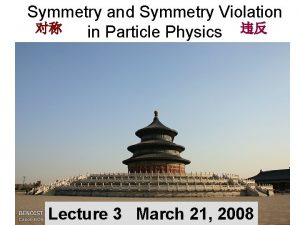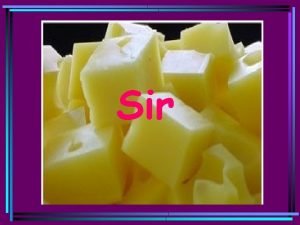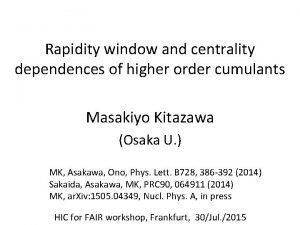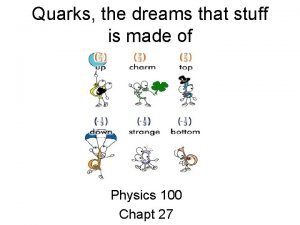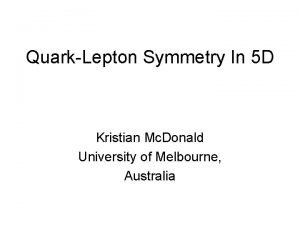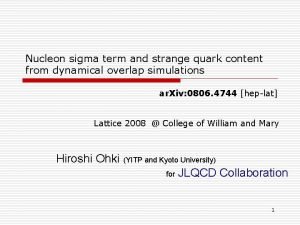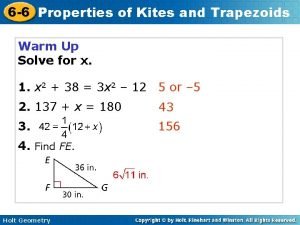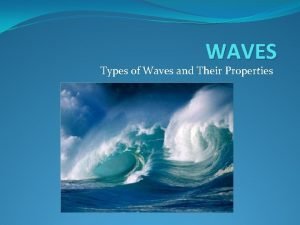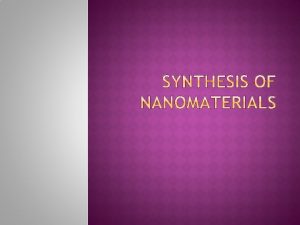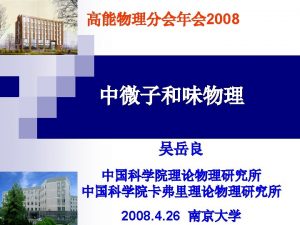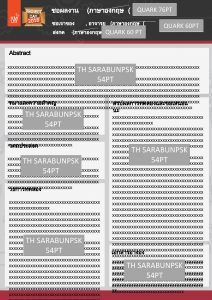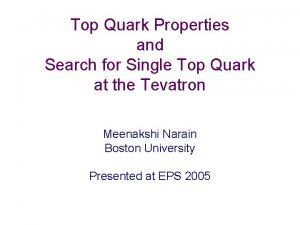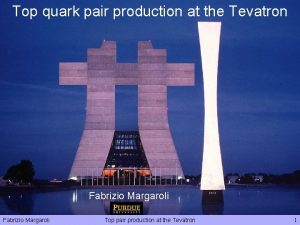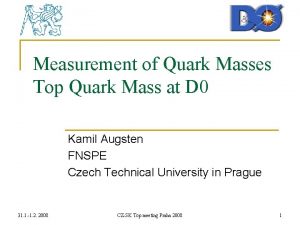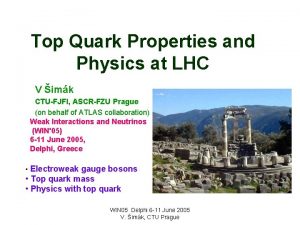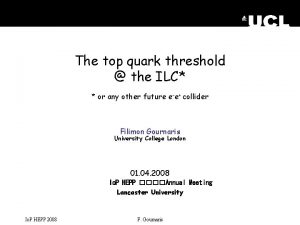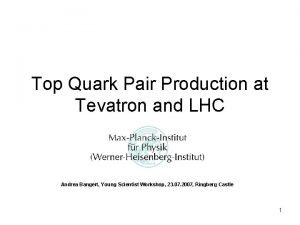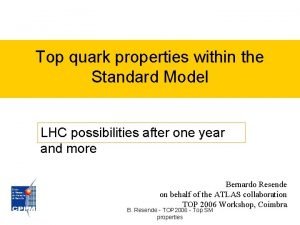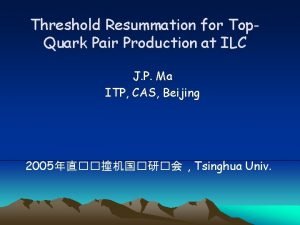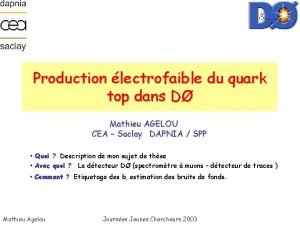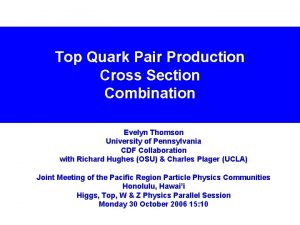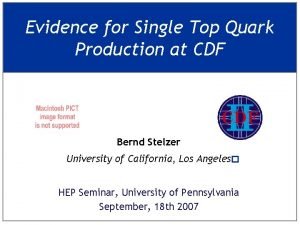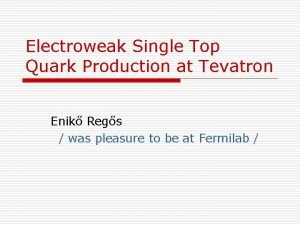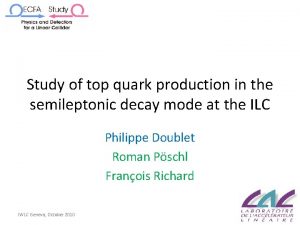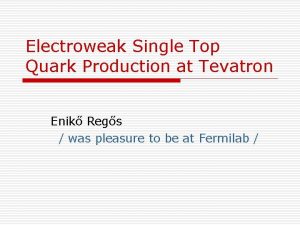Top Quark Production and Properties at D 1




























- Slides: 28

Top Quark Production and Properties at DØ 1. 2. 3. 4. 5. Introduction Top quark production and decay Top quark pair production cross section Top quark production properties i. Top Branching Ratio ii. W-helicity Conclusion and outlook Gustavo Otero y Garzón, University of Illinois at Chicago for the DØ experiment The 2007 Europhysics Conference on High Energy Physics July 19 – 25, 2007, Manchester, England 1

Top Quark CV § Discovered in 1995 by DØ and CDF after a 2 decades hunt § Heaviest fundamental particle (mt = 170. 9 ± 1. 8 Ge. V) § Strongest coupling to the Higgs (Yukawa coupling lt mt ~ 1) § § may help identify the EWSB mechanism and mass generation may serve as a window to new physics related to EWSB that might couple preferentially to top § A unique laboratory: lifetime (5 x 10 -25 s) shorter than the hadronization time makes it decay as a free quark § We still have a lot to learn about this particle Indirect constraints from low energy data and statistically limited Tevatron data leave plenty of room for new physics § Even if the top is “just a normal quark”, precision top measurements are stringent tests of the SM § 2

Top Quark Pair Production and Decay § Top quarks are mainly produced in pairs (strong interactions) at Tevatron energies 15% sttbar / sinel ~ 10 -10 • High luminosity 85% § § § • High efficiency No hadronic bound states due to short lifetime Electroweak decay |Vtb|~1 Final state determined by the decay of the W boson § § § dilepton channel (low bkg) lepton + jets channel (moderate bkg) all hadronic channel (huge bkg) Lepton≡ e, m from W or from t from W 3

Top Quark Production Cross Section § Test of p. QCD at high Q 2 § Sensitive to New Physics • • Higher cross section → resonant state, anomalous couplings Lower cross section → non SM decay modes § Important to measure in different channels and with different techniques § Provides sample composition for top properties measurements § Gives input for searches for which top events are a dominant background 4

Cross Section Results (dilepton) § Combination of ee, mm and em channels • Opposite sign leptons • Significant MET • ≥ 1 jet for em, ≥ 2 jets for ee and mm Ds/s = 22% Improves from PLB 626, 55 (2005) 5

Cross Section Results (lepton + jets) • • • b-tagging 1 isolated lepton (e, m) High MET b-tagged ( ≥ 3 jets), kinematic (≥ 4 jets Kinematic L = 0. 9 fb-1 = 1 tag b-tag Update of PRD 74, 112004 (2006) Kine. Update of PLB 626, 45 (2005) Ds/s = 15% (a), 19%(b) 6

Cross Section Summary Experimental results reaching theoretical precision of 12% (expect 10% with 2 fb -1) 7

Probing the W-t-b vertex § t → Wb / Wq § W helicity fractions 8

Top Branching Ratio This is true at 90%CL if the CKM matrix is unitary and for 3 quark generations Measurement: count b-jets (strongly dependent on R and tagging efficiencies) Njet=3 Njet≥ 4 0. 9 fb-1 9

§ § Result obtained from a binned likelihood fit to data for Njet = 3 and Njet = 4 Simultaneous fit to R and stt Number of Events Top Branching Ratio (II) 0. 9 fb-1 e+jets D Assuming CKM unitarity |Vtb| > 0. 81 @ 95% CL Ds/s = 12% ! Improves from PLB 639, 616 (2006) 10

W Helicity Within the SM the top quark decays via the V-A charged current interaction § W-helicity measurement probes new physics associated with V+A current interactions § left handed longitudinal right handed ff 0 f+ Measure W-helicity through cos(θ*) distribution (l+jets and dilepton events) SM In the SM f 0=0. 7 and f+~10 -4 Fix f 0 to the SM prediction an look for f+ deviations 11

W Helicity (II) § § § Reconstruct top quark and W boson four vectors Compare the cos(θ*) distribution in data to models with different f+ Compute a likelihood L(f+) for the data to be consitent with S+B templates at 7 chosen f+ values l +jets dileptons f+ = 0. 017 ± 0. 048(stat) ± 0. 047(syst) f+ < 0. 14 @ 95%CL when f 0 = 0. 7 Improves from PRD 75, 031102 (R) (2007) 12

Conclusions and Outlook § The Tevatron is still the only top quark factory • § Entering an era of top precision measurements • • § Comprehensive program on top quark measurements is underway Cross section measurements reaching theoretical precision Agreement among channels and with different methods Walking through the largely unexplored territory of top quark properties • • • Measurements are consistent with the SM Analyses based on larger datasets very close Eager to see what the expected 4 fb-1 of data delivered by the end of the year will bring us! 13

Back up slides 14

History of the Top quark 1961: Gell-Mann proposes the quark model to classify the hadron zoo 1977: Lederman & Co. discover the Bottom quark 1973: Glashow predicts the Charm quark u c t g d s b e W Z e H 15

Top Quark Discovery Fermilab’s Run. I started the experimental hunt of the top quark and a long fruitful program in top physics 16

Top Quark Physics W Helicity Production Cross Section Top Charge Top Spin Polarization Spin Correlation Branching Ratios Rare decays Resonance Production Top Mass |Vtb| Still only available at the Tevatron Precise measurements possible for the first time Are they really SM particles? 17

The top quark mass Fundamental parameter of the Standard Model § Affects predictions of SM via radiative corrections mt can be related, with MW, to the Higgs mass dm. W mt 2, ln(m. H) Probing the EWSB mechanism (new physics? ) § Precision measurement → 2 (8) fb-1 projection: dmt ~ 1. 5 (1) Ge. V 18

Top Quark Pair Production LHC Tevatron 19

The Tevatron Collider § § § Proton-antiproton collider with s=1. 96 Te. V 36 x 36 bunches with 396 ns between crossings 3 ~ collisions per bunch crossing Linst > 2 x 1032 cm-2 s-1 Expected 4 -8 fb-1 integrated luminosity for Run. II (0. 11 fb-1 in Run. I) p 1. 96 Te. V CDF `p DØ 20

The DØ Detector Silicon Microstrip Tracker Vertex measurement and tracking § Crucial for b-tagging § 6 barrels and 16 disks with 800000 channels § 15 m position resolution § 21

The DØ Detector Central Fiber Tracker Charged particle tracking (momentum and charge) § 8 concentric cylinders of scintillating fibers § • Two layers per cylinder (axial & stereo) 80000 channels § 100 m position resolution § 22

The DØ Detector EM and hadronic calorimeter Energy measurement and ID of electrons, photons, taus, jets and MET § 3 cryostats with EM, FH and CH sections with ICD § Energy resolutions of 5 -7% for 20 Ge. V electrons and 30% for 20 Ge. V jets § 23

The DØ Detector Muon spectrometer Muon position and tracking § 3 layers of wire chambers (position) and 3 layers of scintillation counters (timing) § 1. 8 T toroid outside inermost layer § 1 mm position resolution and 20% momentum resolution for < 40 Ge. V forward muons § 24

The DØ Detector Other components 2 T solenoid § Luminosity monitor § Preshower detectors § Forward proton detectors § 25

D 0 Triggering p p 2 MHz crossing frequency Data acquisition limited to 100 Hz and not enough resources to store all these events 3 tiered trigger system used to select rare and interesting events. 2 MHz Level 1 2 KHz (4. 2 ms) Level 2 1 KHz (100 ms) Level 3 100 Hz (50 ms) L 1: Hardware based triggers with inputs from different detector subsystems L 2: DSP based triggers L 3: Online event reconstruction 26

Top Mass Measurements Mtop = 170. 5 ± 2. 4 (stat + JES) +1. 2 -1. 1 (syst) Ge. V MATRIX ELEMENT METHOD (0. 9 fb-1) DØ’s most precise measurement Mtop = 173. 7 ± 4. 4 (stat + JES) +2. 1 -2. 0 (syst) Ge. V IDEOGRAM METHOD (0. 42 fb-1) hep-ex/0702018 (accepted for publication in PRD) 27

Top Mass § Improved measurements allows us to reach a 1. 1% precision (DØ and CDF combined) • § aim at < 1% with 8 fb-1 The precise measurement of the top mass helps constrain the mass of the SM Higgs and it is one of the most important measurements at the Tevatron MH = 76+33 -24 Ge. V, MH < 144 @95%CL 28
 Top quark decay
Top quark decay Diagram alir proses produksi
Diagram alir proses produksi Particle wordle
Particle wordle Color quarks
Color quarks Quark names
Quark names Barbara pasquini
Barbara pasquini Quark gluon plasma
Quark gluon plasma Quark gluon
Quark gluon Quark parton model
Quark parton model Quark astronomy
Quark astronomy Quark gluon
Quark gluon Quark names
Quark names Constituent quark model
Constituent quark model A charm quark has a charge of approximately
A charm quark has a charge of approximately Sirutka u prahu vindija
Sirutka u prahu vindija Quark gluon plasma
Quark gluon plasma 6 types of quarks
6 types of quarks Quark lepton symmetry
Quark lepton symmetry Sigma quark composition
Sigma quark composition Quark matter 2022
Quark matter 2022 Intensive vs extensive properties
Intensive vs extensive properties Physical and chemical properties
Physical and chemical properties Inventory management and production planning and scheduling
Inventory management and production planning and scheduling Properties of kite
Properties of kite Wave types
Wave types Top down method
Top down method Move the bottom up and down
Move the bottom up and down Bottom up approach in linguistics
Bottom up approach in linguistics Top-down processing vs bottom-up processing
Top-down processing vs bottom-up processing
